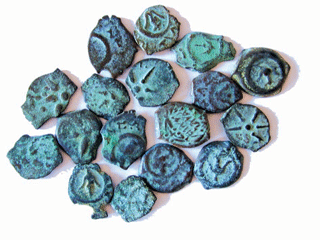
 |
Вдовьи Лепты Все наверно знают пословицу "Внести своию лепту". Некоторые знают, откуда она пошла (Евангелие от Марка, 12-42 : "Пришедши же, одна бедная вдова положила две лепты, что составляет кодрант. Подозвав учеников Своих , Иисус сказал им: истинно говорю вам, что эта бедная вдова положила больше всех, клавших в сокровищницу"). Именно эти монеты, представленные на фотографии, назывались лептами. Они были самой мелкой монетой и по номиналу и по размерам, которые выпускались правителями Иудеи во время Христа, поэтому, чеканились они очень небрежно. Религия запрещала в то время изображать людей и животных на монетах, поэтому основным мотивом на них были изображения колес, рогов изобилия и различные надписи.
Many will be familiar with the Bible story of the ‘Widow's Mites'. The parable that told the story of a poor widow who gave Two Mites as her contribution to the Temple treasury. The story appears in the gospels of Mark 12:42 and Luke 21:2. In the story Jesus contrasts the Widow's offering with that of a rich man who gave bags of gold! The point being that to the poor Widow the two small coins meant much more of a sacrifice than the gold did to a rich man! |